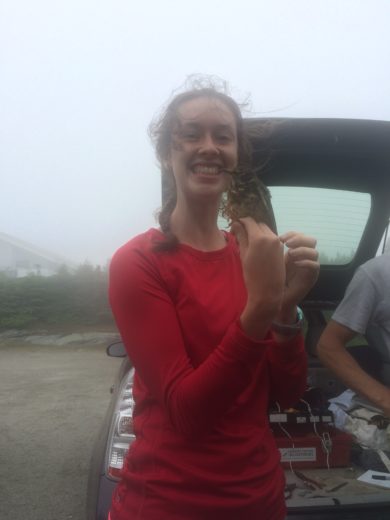The view from Mount Mansfield was spectacular. The ridge line silhouetted against the sky during a warm evening, and the thunderstorm threatening us moved by, just releasing a few drops. I had been looking forward to this trip since I had gotten the call about my internship. I had never banded birds before, although I’d seen it done once with a Herring Gull, but I was eager to learn the process and to finally give it a try myself! The early evening was spent setting up about 25 nylon mist nets, some on and some off the trail. Once everything was in place, we did our first round of checks, hoping for any captures in the nets. Over the next 3 hours, we caught a dozen birds, and I was able to watch as Chris Rimmer showed me the process of banding, how to collect a series of measurements, and how to properly record data. During our second round of net checking, we walked out to an opening in the trees and watched the sunset with an astonishing view! After closing nets at dusk, it was time to head back down to our overnight digs in the ski patrol hut. The winds had started to pick up again and I was worried that they might be too strong for the morning, but after banding the final few birds (who stayed with us overnight in their cloth “sleeping bags”) and late dinners in the hut, we rolled out our own bags and hoped for the best in the morning.
After a short but restful four hours of sleep, the alarm roused us at 3:45 am. The wind was still right where we had left it, but fortunately, it was just calm enough for us to continue with the mist nets! We walked our routes and opened the 25 nets in the pre-dawn. As the sun rose and warmed the air, our nets soon became filled with birds! We made many trips to and from the nets to untangle any and all birds that had been caught, and by the time we made our way back through the nets to the cars, more birds had become tangled in the nets. It was one of the busiest days up on the mountain this summer, and everyone worked quickly and diligently to band, measure, weigh, and release every bird.
Once the bird traffic had calmed down and all the birds, except for one, lined up on the queue had been released, it was my turn to step in! I untied the last bird bag from the line and brought it to the back of the banding station (Chris’s Prius). Chris had showed me the two proper ways to hold a bird, so I reached my hand into the cloth bag and carefully gripped the baby robin inside. Robins are feisty birds and will definitely make sure you hear them loud and clear! After a few bites at my fingers I successfully grasped the bird, brought it out of the bag, applied a uniquely-numbered aluminum band to its right leg, and started with the measurements. With each bird that is caught for the first time, we always make sure to apply the band first, before we take any measurements. This is very important just in case the bird escapes the holder’s grasp before all the data are recorded. Of course, I was at first a bit nervous to attach the band, since song birds are so small and delicate, but after handling the robin for several minutes, I realized it was comfortable enough, and so was I, to proceed. I placed a small metal band #1152-92894 in the special pliers, slipped it over the robin’s leg, and carefully secured it in place. I then measured the bird’s wing and tail length, checked its fat and feather wear, and weighed it. With excitement, I released the robin and celebrated my first bird banding experience!
To learn more about this trip up Mount Mansfield, read Chris Rimmer’s account too!

